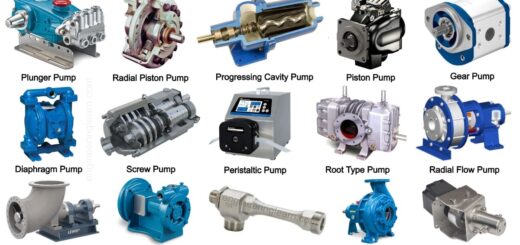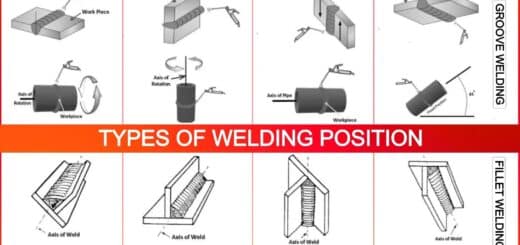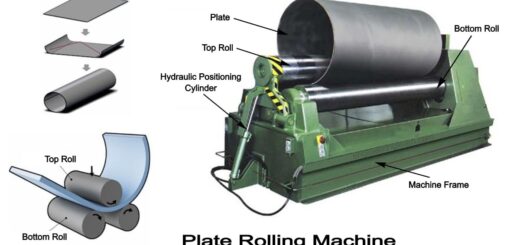Types of Evaporator and Their Applications [with Pictures]
![Types of Evaporator and Their Applications [with Pictures]](https://engineeringlearn.com/wp-content/uploads/2021/09/Evaporator-1024x539.jpg)
Types of Evaporator and Their Applications [with Pictures] :-
Types of Evaporators
1. Falling Film Evaporator: ( Types of Evaporators )
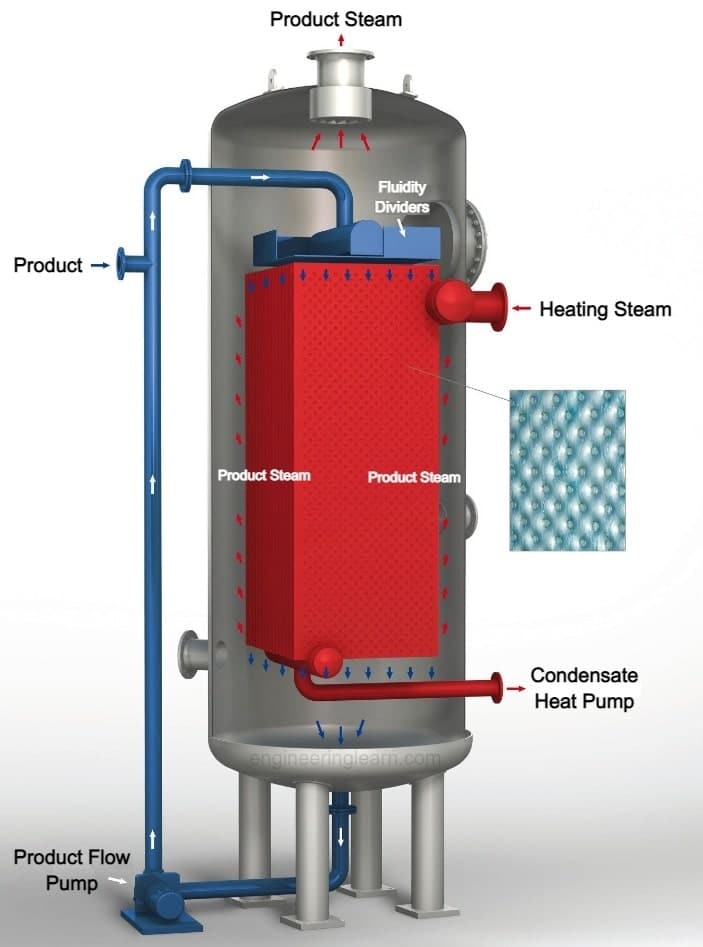
Falling film evaporators are made up of 13 ft to 26 ft tubes which is enclosed with the steam jackets. Falling film evaporators require uniform distribution of solution. The solution in this evaporator enters from top from where distributor distributes it evenly to every tube. In this evaporator, as the solution flows downward it gains velocity due to the gravitational pull. As the vapour developed gradually in response to the heating medium, the velocity increases as well. Falling film evaporators are used for high viscous solutions therefore they are usually used for sugar, chemical, fermentation and food industries.
Application of Falling Film Evaporator
Falling film evaporator are used for sugar solution, black liquor, concentration of dairy products and phosphoric acid
2. Forced Circulation Evaporator: ( Types of Evaporators )

These evaporators are also known as natural circulation evaporator and these evaporators are generally based on natural circulation which is the result of the difference in density which arises due to the heating. Due to the use of tubes when water starts boiling then it results in rise of bubbles which leads to the circulation and thus separates the vapour as well as the liquid at the top of heating tubes. Evaporation amount directly depends on temperature difference between solution and the steam.
The main problem with forced circulation evaporators arises when the tubes of evaporator do not completely immersed in solution and this will create compromised circulation and dried out system. To overcome this problem, circulation are achieved with the help of inserting a pump for increasing the circulation as well as pressure. This type of circulation generally takes place when the hydrostatic head restrict the boiling at heating surface.
Forced circulation evaporators are generally used in waste streams, viscous fluids, crystallizers and various of difficult process fluids, the suppressed boiling can helps in reducing the fouling and scaling. Pump can also helps in reducing fouling which is caused by liquid boiling on tube because the pump can reduce the formation of bubble. Few other problem in the forced circulation evaporators are undefined residing time and high consumption of stem but for high temperature it is easy to achieve good circulation.
Application of Forced Circulation Evaporators
Forced circulation evaporators are used for sodium sulphate, citric acid, urea, sodium chloride, caustic potash, ammonium sulphate and magnesium chloride.
3. Climbing and Falling-Film Plate Evaporator: ( Types of Evaporators )
These evaporators have generally larger surface area. The plates are generally supported with the help of frame and are corrugated. At the time of evaporation the steam will flow through the free space channels which are in between plates, steam climbs and then fall parallel to the liquid which is concentrated. In relation to liquid, the steam will follow counter current path. The vapour as well as the concentrated liquid is then sent to separation stage in which vapour is sent to the condenser. Due to the spatial flexibility this evaporators are generally used for fermentation and dairy industries. The disadvantage of this evaporator is that their ability is limited in treating solid containing and viscous products.
Application
Climbing and falling film plate evaporator are used in dairy industries.
4. Rising / Falling Film Evaporator: ( Types of Evaporators )
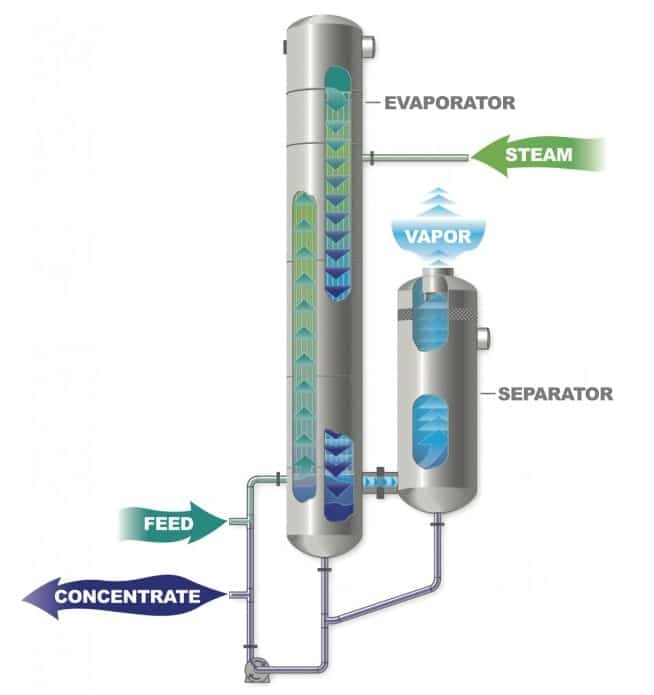
This evaporator are combination of a falling film evaporator and the rising film evaporator therefore it provide the advantage of both the evaporators. These are used for high ratio of evaporation with feed, and the bundles of tube are segmented in two different parts, in which first part are operated as rising film and second part are operated as falling film.
Application
Rising/ Falling film evaporator are used for handling of foamy liquids or liquids in which there are high evaporation load.
5. Rising Film / Long Tube Vertical Evaporator: ( Types of Evaporators )
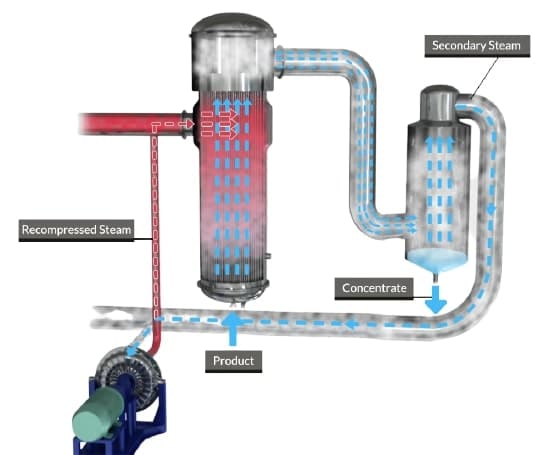
In this evaporator boiling occur in the tubes because the heating is done outside the tubes generally by steam. Therefore submergence is not required. These evaporators are generally efficient but the major disadvantage is that scaling occurs quickly in the internal surface of tubes. So, this evaporator is suitable for non salting and clear solution. Tubes in this evaporator are generally long which can be more than 4 meters. Deciding the size of the evaporator is difficult because it need precise calculation of level in process liquid in tubes.
6. Agitated Thin Film Evaporator: ( Types of Evaporators )
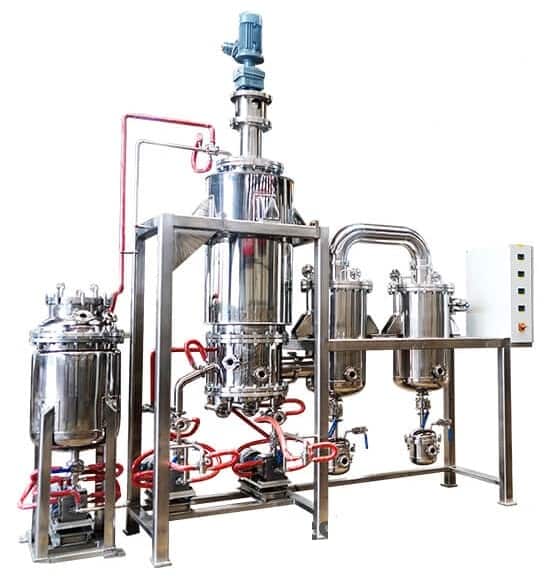
It is very useful for the products which is difficult in handling. These evaporators are able in the separation of volatile component from the components which are less volatile with the help of mechanical agitation and indirect heat transfer of flowing product film in control condition. This separation is done in vacuum condition for maximizing the change in temperature with maintaining temperature which is favorable for product. There are some technical issues occur at the time of evaporation.
There are few evaporators which can be sensitive to viscosity difference as well as consistency of dilute solution, these evaporators results in inefficient work due to the circulation loss. When high viscous solution is needed to be concentrate then evaporator’s pump are changed.
Fouling in evaporator takes place when stiff deposits create surface on the heating medium of evaporators, it occurs in case of proteins, food and they ultimately decrease the heat transfer efficiency.
Application of Agitated Thin Film Evaporator
Agitated thin film evaporators are commonly used for purifying organic chemicals which include insecticides, natural oils, herbicides, fatty acids. Pharmaceuticals and food concentration which include biological solution, fruit purees and vegetable purees, vegetables and plant extracts etc.
7. Multiple Effect Evaporator: ( Types of Evaporators )
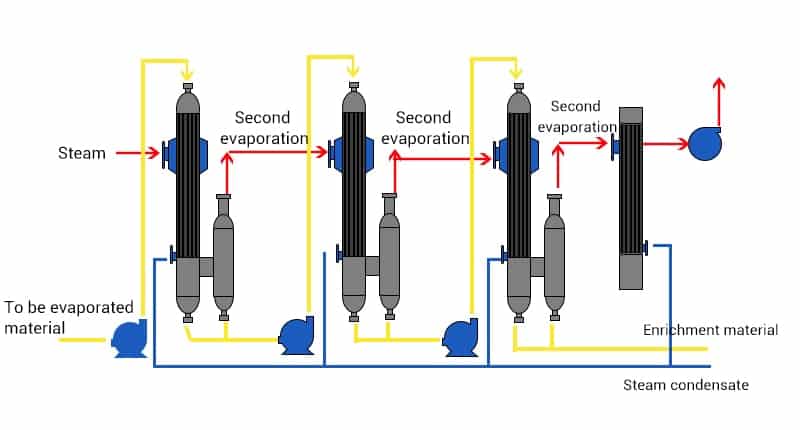
These evaporators are manufactured of seven evaporators effects/ stages. The requirement of energy for single effect evaporators are huge and are responsible for most of the cost of evaporation system. By putting seven evaporators effects/ stages together can save the heat requirement therefore need less energy. By providing one evaporator to the existing original one results in reduction of energy consumption by 50 percent, and further addition of a evaporator will reduce the energy consumption by 33 percent. There is a heat saving percent which is used for the estimation of how much energy is saved with the addition of a particular number of effect. Generally in multiple effect evaporators, the number of effects are kept to seven because at seven effect the equipment cost will reach to cost saving.
Image Source :- thermopedia, hedhme, lob-gmbh, hanputech, topdistillation, thermalkinetics, prsubmissionsite,
